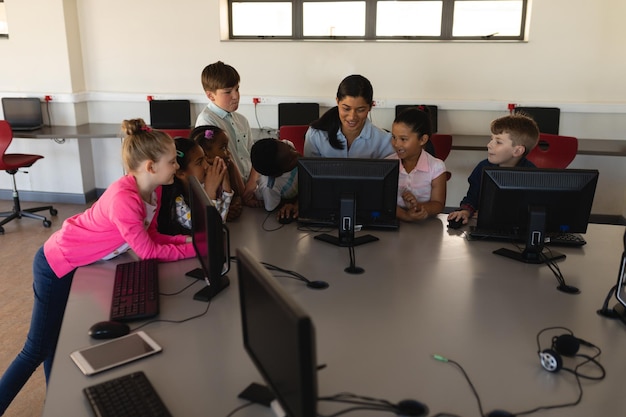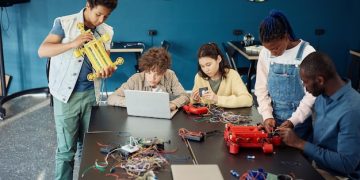Bridging the Digital Divide: Tech Initiatives in US Schools

The digital divide in US schools is increasingly being addressed through various technology initiatives, including providing devices, improving internet access, and offering digital literacy programs to ensure equitable access to educational resources.
The digital divide: how schools are bridging the gap with new technology initiatives remains a critical issue in US education, impacting students’ access to essential learning tools. Schools across the nation are actively implementing strategies to level the playing field, ensuring every student has the opportunity to succeed in a digitally driven world.
Understanding the Digital Divide in US Education
The digital divide refers to the gap between those who have access to modern information and communication technologies and those who do not. In US education, this divide often manifests as differences in access to computers, internet, and digital literacy skills, creating significant barriers to learning for many students.
The Impact on Students
The lack of access to technology can significantly hinder students’ academic performance and future opportunities. Students without reliable internet access at home may struggle to complete homework, conduct research, or participate in online learning activities. This disparity can exacerbate existing inequalities, particularly for students from low-income families and marginalized communities.
Contributing Factors
Several factors contribute to the digital divide, including affordability, infrastructure limitations, and digital literacy skills. Low-income families may not be able to afford computers, tablets, or internet access. In rural areas, infrastructure limitations can lead to unreliable or non-existent internet service. Additionally, a lack of digital literacy skills can prevent individuals from effectively using technology, even if they have access to it.

To address the digital divide effectively, schools need to consider these contributing factors and implement comprehensive strategies that provide not only access to technology but also the necessary support and training to use it effectively.
- Affordability: Providing low-cost or free internet access and devices to low-income families.
- Infrastructure: Investing in broadband infrastructure to improve internet access in rural and underserved areas.
- Digital Literacy: Offering digital literacy training to students, teachers, and parents.
Understanding the multifaceted nature of the digital divide is the first step toward creating equitable access to technology and ensuring that all students have the opportunity to thrive in the digital age. By addressing the root causes and implementing targeted interventions, schools can help bridge the gap and promote digital equity.
Initiatives Providing Devices to Students
One of the most direct ways schools are addressing the digital divide is by providing devices, such as laptops and tablets, to students. These initiatives aim to ensure that every student has access to the tools they need to succeed in the digital age, regardless of their socioeconomic background.
One-to-One Programs
One-to-one programs involve providing every student with their own device, typically a laptop or tablet. These programs are often funded through a combination of federal, state, and local resources, as well as private donations. By ensuring that each student has a dedicated device, schools can create a more equitable learning environment and promote personalized learning.
Device Lending Programs
Device lending programs allow students to borrow devices from the school for use at home. These programs are particularly helpful for students who do not have access to a computer or tablet at home. Schools often partner with local organizations and businesses to secure funding for these programs and ensure that devices are available to all students who need them.
Providing devices to students is a crucial step in bridging the digital divide, but it is only one piece of the puzzle. To ensure that these initiatives are effective, schools must also provide ongoing support and training to students, teachers, and parents. Additionally, schools must address the issue of internet access, as a device is only useful if students can connect to the internet.
- Funding: Seek diverse funding sources, including grants, donations, and partnerships.
- Support: Provide technical support and training for students and teachers.
- Accessibility: Ensure devices are accessible to students with disabilities.
Enhancing Internet Access for Students
Access to reliable internet is essential for students to complete homework, conduct research, and participate in online learning activities. However, many students, particularly those from low-income families and rural areas, lack access to broadband internet at home. Schools are implementing various initiatives to address this issue and ensure that all students can connect to the internet.
Wi-Fi Hotspots
Some schools are installing Wi-Fi hotspots in strategic locations, such as community centers and libraries, to provide students with free internet access. These hotspots allow students to connect to the internet outside of school hours and complete their assignments. Schools often partner with local organizations to manage and maintain these hotspots.
Mobile Hotspots
Mobile hotspots are portable devices that provide internet access through a cellular network. Schools are providing mobile hotspots to students who lack access to broadband internet at home. These devices allow students to connect to the internet from anywhere, making it easier to complete homework and participate in online learning activities.

Enhancing internet access for students is a critical component of bridging the digital divide, but it is not without its challenges. Schools must navigate complex issues, such as funding, infrastructure limitations, and data privacy concerns. However, by working collaboratively with local communities and leveraging innovative technologies, schools can overcome these challenges and ensure that all students have access to the internet.
- Partnerships: Collaborate with internet service providers to offer low-cost or free internet access.
- Funding: Seek funding opportunities to support the cost of internet access and equipment.
- Security: Implement security measures to protect student data and privacy.
By investing in internet access initiatives, schools can create a more equitable learning environment and empower students to succeed in the digital age. These initiatives not only benefit students but also strengthen communities by promoting digital inclusion and economic opportunity.
Digital Literacy Programs in Schools
Digital literacy is the ability to use technology effectively and critically. It encompasses a wide range of skills, including the ability to find, evaluate, and create information using digital tools. Schools are implementing digital literacy programs to equip students with the skills they need to navigate the digital world and become responsible digital citizens.
Curriculum Integration
Many schools are integrating digital literacy skills into their existing curriculum. This approach ensures that students learn these skills in the context of their regular coursework. Teachers receive training on how to incorporate digital literacy activities into their lessons, and students have opportunities to practice these skills in a variety of settings.
Workshops and Training Sessions
Schools are offering workshops and training sessions for students, teachers, and parents to enhance their digital literacy skills. These sessions cover a wide range of topics, including internet safety, online research, and digital content creation. By providing targeted training, schools can help individuals develop the skills they need to use technology effectively and responsibly.
Digital literacy programs are essential for bridging the digital divide and ensuring that all students have the skills they need to succeed in the digital age. These programs empower students to become active participants in the digital world and prepare them for future careers in a technology-driven economy. By investing in digital literacy, schools can create a more equitable and inclusive learning environment for all students.
- Teacher Training: Provide ongoing professional development for teachers to enhance their digital literacy skills.
- Community Engagement: Involve parents and community members in digital literacy initiatives.
- Assessment: Develop assessments to measure students’ digital literacy skills and track progress.
Collaborative Efforts: Schools, Communities, and Businesses
Bridging the digital divide requires a collaborative effort involving schools, communities, and businesses. By working together, these stakeholders can leverage their resources and expertise to create sustainable solutions that address the root causes of the digital divide.
Partnerships with Local Businesses
Schools are partnering with local businesses to secure funding, equipment, and expertise for their digital equity initiatives. Businesses can provide donations, volunteer time, and offer internships to students interested in technology. These partnerships not only benefit schools but also provide businesses with opportunities to give back to the community and develop a skilled workforce.
Community Organizations and Nonprofits
Community organizations and nonprofits play a vital role in bridging the digital divide by providing access to technology, training, and support to underserved populations. Schools are collaborating with these organizations to offer after-school programs, summer camps, and other initiatives that promote digital inclusion. By working together, schools and community organizations can reach a wider audience and provide comprehensive support to students and their families.
Collaborative efforts are essential for creating sustainable solutions to the digital divide. By leveraging the resources and expertise of schools, communities, and businesses, we can ensure that all students have the opportunity to succeed in the digital age. These collaborations not only benefit students but also strengthen communities by promoting economic development and social equity.
- Shared Goals: Define clear goals and objectives for the collaboration.
- Open Communication: Establish open lines of communication between partners.
- Resource Sharing: Pool resources and expertise to maximize impact.
The combined efforts of academic institutions, local governments and local commercial enterprises will continue to be a factor in how the digital divide can be mitigated in the US education system.
Measuring the Success of Technology Initiatives
To ensure that technology initiatives are effective in bridging the digital divide, schools must measure their success. This involves collecting data on student access to technology, digital literacy skills, and academic outcomes. By analyzing this data, schools can identify areas for improvement and refine their strategies.
Data Collection Methods
Schools can use a variety of methods to collect data on the impact of technology initiatives. These methods include surveys, focus groups, and student assessments. Surveys can be used to gather information on student access to technology and their attitudes toward digital learning. Focus groups can provide qualitative insights into the challenges and opportunities associated with technology integration. Student assessments can be used to measure students’ digital literacy skills and academic progress.
Key Performance Indicators
Key performance indicators (KPIs) are specific, measurable metrics that schools can use to track the success of their technology initiatives. KPIs may include the percentage of students with access to devices and internet, the number of students participating in digital literacy programs, and improvements in student test scores. By monitoring these KPIs, schools can determine whether their initiatives are achieving their intended outcomes and make adjustments as needed.
- Regular Assessments: Conduct regular assessments to monitor progress and identify areas for improvement.
- Feedback Mechanisms: Establish feedback mechanisms to gather input from students, teachers, and parents.
- Data Analysis: Analyze data to identify trends and patterns.
Measuring the success of technology initiatives is essential for ensuring that they are effective and sustainable. By collecting data and analyzing KPIs, schools can make informed decisions about how to allocate resources and improve their strategies. This data-driven approach will help schools close the digital divide and create a more equitable learning environment for all students.
| Key Point | Brief Description |
|---|---|
| 💻 Device Provision | Schools offer laptops/tablets to bridge the device gap. |
| 🌐 Internet Access | Implementing Wi-Fi and mobile hotspots for students. |
| 📚 Digital Literacy | Teaching critical tech skills via curriculum and training. |
| 🤝 Collaboration | Schools partner with communities and businesses. |
Frequently Asked Questions
▼
The digital divide refers to the gap between students who have access to technology and internet and those who don’t, impacting their ability to learn and succeed academically.
▼
Schools implement one-to-one programs, giving each student a device. They also use lending programs where students can borrow devices for home use.
▼
Schools are creating Wi-Fi hotspots in local areas and providing mobile hotspots to students, ensuring they can connect from home and other locations.
▼
These programs teach students how to use technology effectively and safely, including evaluating online content and creating digital materials responsibly.
▼
Partnerships between schools, communities, and businesses allow for shared resources and expertise, addressing the divide more effectively through combined efforts.
Conclusion
Bridging the digital divide: how schools are bridging the gap with new technology initiatives requires a multifaceted approach that addresses access to devices, internet connectivity, and digital literacy. By implementing comprehensive strategies and fostering collaboration among schools, communities, and businesses, we can ensure that all students have the opportunity to succeed in the digital age.





